Thwarting any expectation that our year end list making activities may have been completed, over the last two weeks we’ve been compiling a list of what we think are the best and worst exhibitions and talks of the year. The list obviously can only include those exhibitions we’ve seen, so if you are wondering why, for example, the Goya show at the Frick, Amy Sillman at Sikemma Jenkins or “Frederic Church, Winslow Homer, and Thomas Moran,
Tourism and the American Landscape”, Cooper-Hewitt, National Design Museum have been slighted, please bear in mind the inherent fallibility of a list put together by one person. You can only see so many shows, and sometimes you have to miss exhibitions you know you shouldn’t.
THE BEST ART OF 2006
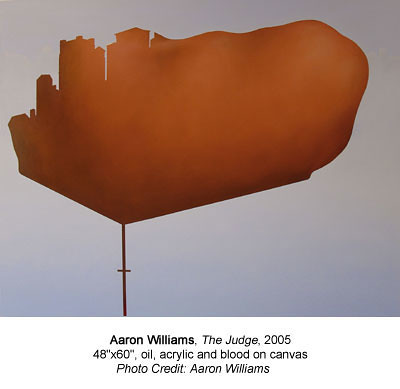
10. Aaron Williams at Baumgartner Gallery, (January 14- February 15, 2006)
In January 2006, Baumgartner Gallery launched emerging artist Aaron William’s first solo show which consisted of 6 mid to large sized abstract paintings. For the most part the exhibition seemed to be overlooked by the press, and while we’re not sure why, (though we do speculate,) we are happy to reiterate some of sentiments we expressed last year about the exhibition – namely that while the surface of these paintings is undeniably seductive, it is merely a packaging device for the larger ideas behind the work. To quote myself:
While all the works in the show demonstrate a high degree of painting skill the most successful are those that most specifically depict a moment of decision that leads to transfiguration…The Judge [for instance] suggests that the weight of human experience is balanced on something unseen or unknown. There is a sense that judgment is impending and that it will come from a source outside of us, and greater than us.
To read the full review click here.
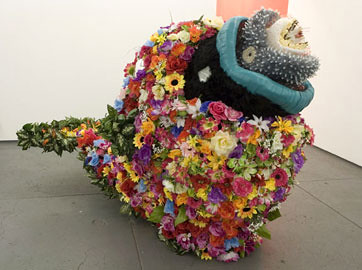
Jumbo, 2006
Plexiglas, epoxy, hot glue, foam, mixed media
56 x 88 x 32 inches
9. Diamonds Cut Diamonds, at Rare Gallery, (June 22 – July 29)
You can criticize sculptor Johnston Forester’s Diamonds Cut Diamonds, for being overly zeitgeist, but ultimately the criticism will be limited because the participating artists exhibit too much skill to be a flash in the pan. David Choi’s Jumbo, a giant flowered piranha is a tour de force of epoxy and man-made materials, the classical sculptures carved out of Polystyrene insulation by Morgan Herrin put sensation sculptor Marc Quinn’s 2005 exhibition The complete Marbles at Mary Boone to shame, (not that this is overly difficult, but Quinn did receive a baffling number of positive reviews for a very easy show) and Brian Basnett’s tiny soft sculptures made from found plastics are whimsical, but not at the expense of being personal and warm.

Image copyright Justin Strawhand and Marcin Ramocki
8. 8-BIT: A Documentary About Art and Video Games, (Premiered October 7, 2006 at MoMA)
Undoubtedly my favorite documentary of 2006, and probably the most important 8-BIT, represents the first attempt in the medium of film to treat video games as a medium separate from television, video, music, etc. The movie packs a lot of information about the genre at once, so while may take than one viewing to fully grasp all the concepts, but it’s well worth the time spent. Artists and musicians discuss their work articulately and succinctly, and unlike many documentaries, 8-BIT by its very nature is not plagued by a bad soundtrack. To read my full review of this film click here.

Paul Slocum, Deep House for Symphonic Band and Choir, (Installation View), 2006
7.Paul Slocum, Vertexlist (October 14 – November 2006)
I believe I have a half written post that never got published about Paul Slocum’s performance and exhibition at Vertexlist, which is a real shame because the work easily makes our top 10 list. I particularly enjoyed his performance which, involved a score he wrote and programmed into a game cartridge, so that if Slocum died in the course of playing the game, the piece would end early. It’s the sort of piece that only succeeds if a) the music is good, and b) it builds in some way, since without which, viewer investment in the outcome of the game amounts to nothing. Needless to say I REALLY cared about Slocum winning the match. Also on display was Century Caller, (which appears to be turned off right now) and my personal favorite Deep House for Symphonic Band and Choir, 2006, a piece Slocum himself describes as a “dance club hit written for symphonic band and choir.” Explaining the work further on his blog, he writes, “The music plays on the speakers in a loop (about 4 mins long) and the entire score for all the instruments is pinned to the wall between two Sylvania Gro-Lux fluorescents.” Tom Moody likens the wall piece to a Sol LeWitt drawing, which was the first reference that came to my mind as well. You can read Moody’s full review here, and listen to the piece here.
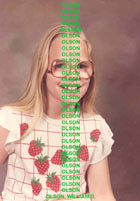
Marisa Olson, Image courtesy EAI
6. Net Aesthetics 2.0, (February 6th)
Normally, lectures don’t meet the ranks of exhibitions, but we make a notable exception this year for Net Aesthetics 2.0, a discussion panel curated and moderated by the Executive Director of Rhizome Lauren Cornell, because it is now referenced so frequently by the net community. It’s not that the discussion resolved the debate as to what this term really means – at least it didn’t for me (if you missed the discussion as I did, you can listen to it here,) but it did shed some light on the different approaches artists are taking and how the web and net art is evolving. I was particularly interested in the last question of the evening that came from audience member Barry Hoggard, who aptly observed that at no point had any net artist invited discussed the role of beauty. A variety of responses were given, but it was clear that while the panelists have undoubtedly pondered the subject, generally speaking, it was not a dominant concern to their art making process. Just something to keep in mind…
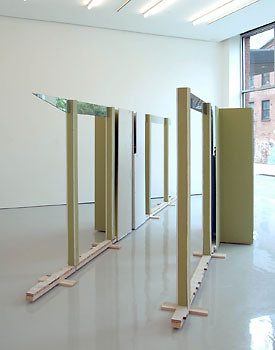
Heather Rowe, Green Desert, 2006
Image Copyright D’Amelio Terras
5. Heather Rowe, at D’Amelio Terras, (July 13-August 11)
Here’s an artist who’s work does not document well. Rowe’s Green Dessert hides beautiful fragments of moldings and mirrors within the scaffolding like structure, and showing that beauty can be found nestled within the nooks and crannies of suburban architecture. There is much more to these sculptures than a photograph will ever capture. Read my review here and James Wagner’s here.
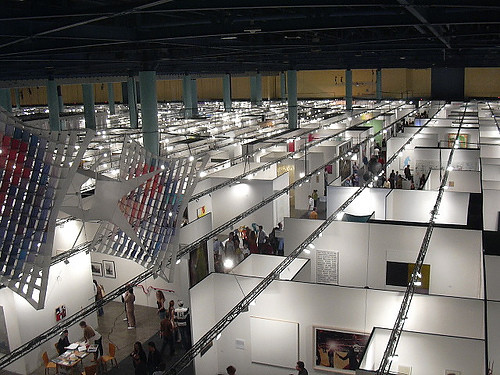
Photo AFC
4. Art Basel, Miami, (December 6th – 10th)
This fair is problematically situated at number 4 on our list as it means that we are essentially saying that established modern masters are not as interesting as those who grab the higher positions. Well, there’s nothing to be done about that accept to acknowledge the issue, and move on: Admittedly fairs are not the best way to look at art, as the “if-it’s-not-hung-you-can’t-sell-it” aesthetic dominates these shows. However, Art Basel does provide an art audience with the unique opportunity to see large amounts of high quality art work at one time. This means that the fair centric insult lodged at art that inspires collectors to request to meet the artist, (to see just how smart they are) generally comes in smaller proportions at Basel. Also, despite the fact that the fair’s labyrinth like grid had me lost in a matter of minutes, all of the galleries featuring emerging artists were placed around the circumference of the room, which gave them a decided advantage as markers (unless of course you happened to be located near Gavin Brown’s booth, in which case you were probably overshadowed.) Read my full review here.
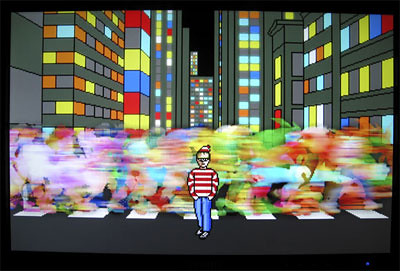
Michael Bell-Smith, Self Portrait NYC, 2006
Video Loop 2:00 min
3. Michael Bell-Smith, Foxy Production, (April 27 – June 3)
Michael Bell-Smith is having a good year at AFC, being mentioned twice earlier on our best of the web list, and now grabbing the number 3 position amongst exhibitions. Disappointingly, no major critic brought significant insight to the value of the video and ephemera showcased in Focused, Forward, though I suspect the mounting excitement about Bell-Smith’s work will inspire more in-depth pieces in the future. I can’t claim that we’ll be able to bring any deep analysis to the work in this short synopsis, (though I invite you to read the three part interview with the artist, Tom Moody and myself here, here, and here,) though we will note that the video short Self Portrait NYC, (which can be viewed on the Foxy website here) is amongst the stronger in the show, and our personal favorite. The work features a cartoon version of artist as the city slowly transforms itself at night. Becoming cloud-like in nature the crowd behind him dissolves, and New York, though merely a flat stage behind him, feels oddly clean and endlessly desirable. I believe this can be attributed to the magic stars twinkling in the background.
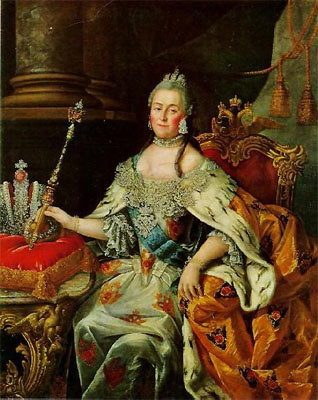
Image copyright Malaspina.edu
2. Catherine the Great (Art Gallery of Ontario), October 1, 2005- January 3 2006)
I know, I know, the Art Gallery of Ontario rests outside the geographical area what we claim to report on, but then again so do the Miami art fairs, and they made our list too. What can I say? Excellence deserves record, regardless of its location.
Although Catherine the Great launched in 2005, it ran into 2006 for all of three days before closing, thus making it eligible for this list. Hosting some of the stunning holdings of the State Hermitage Museum certainly helped make this show great, (I was particularly impressed with a number of the portrait commissions and the Coronation Coach), but the curation and scholarship is what made this show so remarkable. “Catherine the Great, Empress of Russia (1729—1796), was one of history's greatest art patrons — and one of its shrewdest political leaders.” reads the press release, “For her, art and politics were inseparable. By her acquisition of important works of art from the past, and her patronage of the foremost artists of her time, she not only formed one of the finest collections in the world, but spectacularly transformed St. Petersburg into one of the cultural capitals of Europe.” And each work exhibited underscores this thesis. You can’t look at this exhibition and not draw connections between the role Hollywood has in American Culture, and the role Catherine the Great assigned to culture. As text for the show wisely concludes, “these works speak volumes about the power of culture and the culture of power”

Image copyright Printed Matter
1. New York Art Book Fair, (November 16-19, 2006)
While the event bills itself differently, The New York Art Book Fair hosts exhibitors who sell works that I not only desire, but can even, on occasion, afford. That’s an achievement I would have thought impossible last year, since it’s not like blogging gives us a huge budget to work with. Housed at the old New Museum location, the fair a variety of art, which in addition to books of all shapes and sizes included prints, photographs, drawings and sculptures. The downstairs featured all matter of fetish inducing printed material, which can be read about here in my full review, while the upstairs constituted renegade aspect of the fair, showing artist collectives, small art book publishers and oddly, Phiadon. There were also plenty of martini’s opening night, which if nothing else, would have ensured this bloggers return in 2007.

Noah Fischer, Rhetoric Machine, Installation view, 2006
Bonus: Noah Fischer, Rhetoric Machine, at Oliver Kamm Gallery, (November 30-January 6th)
Last April or there abouts I saw Noah Fischer perform in a largish industrial space in Tribeca. In collaboration with three other artists, his performance using sequenced light was one of the best I had seen, but it never got written up here because I had foolishly not taken any notes, and every time I tried to explain it I made the work sound like a hokey theater production. Rhetoric Machine, which just closed at Oliver Kamm, is an installation that borrows many of the same lighting techniques he had used in that performance and building upon these devices to create a environment of speech making that highlights the construction of the political agendas they support. This work would be best showcased at The Kitchen, which has a long tradition of supporting political and performance based work.


{ 8 comments }
Amazingly artistic….awesome pictures….very informative and interesting…..Loved the site…looking forward for more…
Truly unique and artistic! I wish to know and see more here soon.Thanks for sharing these!
The Judge [for instance] suggests that the weight of human experience is balanced on something unseen or unknown
Wonderful post.Thanks
For the most part the exhibition seemed to be overlooked by the press, and while we’re not sure why
This is great art. This is the coolest thing ever!!! Thanks for sharing
Awesome info once more. Thumbs up!
I wanted to thank you for this interesting I definitely loved every bit of it. I have you bookmarked your internet site to look at the latest items you post.
Comments on this entry are closed.
{ 1 trackback }